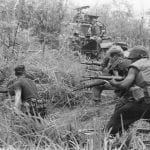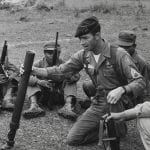The following article on Vietnam War aircraft is an excerpt from Warren Kozak’s Curtis LeMay: Strategist and Tactician. It is available for order now from Amazon and Barnes & Noble.
At the start of 1962, the U.S. had 16,000 military advisors training the South Vietnamese army in its fight against the Viet Cong and the Communist government based in Hanoi. In early February, the Pentagon set up a permanent U.S. military presence in Saigon—the Military Assistance Command in Vietnam (MACV). The U.S. military presence in a country that most Americans knew very little about would only grow from that point on.
In April, Air Force Chief Curtis LeMay went to Vietnam for an inspection tour and met with the head of MACV, General Paul Harkins, as well as the President of South Vietnam, Ngo Dinh Diem. While MACV was concentrating its efforts in the South, LeMay saw that the real problem was clearly coming from the North. LeMay made the same recommendation he made twelve years earlier, for Korea—if the U.S. intended to stop this infiltration, a massive bombing campaign of the North would do the trick. LeMay zeroed in on the port facility in Haiphong, where the weapons and supplies were coming in from the Soviet Union, and proposed bombing it. He believed this would put a halt to the guerrilla war in the South, but the plan was much too bold for the tentative steps that the Kennedy Administration was making in Vietnam in 1962.
Vietnam War Aircraft: A Focus on Bombers
Ten years and 59,000 American lives later, the U.S. did exactly what LeMay had suggested. From December 19 to 29, 1972, the Air Force and Navy conducted Linebacker II, the largest concentrated bombing since World War II. The bombing of the North Vietnamese capital, Hanoi, and the port of Haiphong was conducted by such Vietnam War aircraft as tactical fighters, along with 741 B-52 sorties. Ten B-52s were shot down, five crash-landed in Laos and Thailand, thirty-three B-52 crewmen were killed, thirty-three were captured, and twenty-six were rescued. After years of stops and starts, the massive bombing of Vietnam War aircraft finally pushed the North Vietnamese to hammer out a negotiated settlement that gave the U.S. a way to extricate itself from its tortured involvement.
Decades later, the political debate over this conflict remains unresolved. Kennedy aide Ted Sorensen strongly disagreed with the suggestion that the conflict may have ended sooner had LeMay’s plan been followed ten years earlier, “I don’t know how you can say this so many years after the fact, especially when you consider that the Vietnamese had been fighting for their independence since forever and the idea that some bombs in Hanoi or Haiphong would have brought them to the table is ludicrous.”
But former Secretary of Defense, James Schlesinger, countered Sorensen’s view. “That’s ridiculous, the myth that it was a civil war. What destroyed Vietnam was that 18 divisions came down from the North in 1975. There was nationalism in Hanoi but not in the South and it was the North imposing its view on the South.” Schlesinger also points out that had the strikes taken place earlier when LeMay suggested them, the Soviet surface-to-air missiles would not have been in place, saving the U.S. planes and crews that were shot down a decade later.
Vietnam highlighted the greatest difference between LeMay’s philosophy of war and Defense Secretary Robert McNamara’s. The Defense Secretary pushed for what he called flexible response from the very start of the U.S. involvement in the conflict: namely, offering the enemy a way out; however, if they show aggression, match the aggression, but only proportionately. Consequently, the full weight of the growing American military was never brought to bear on the North. Ground would be fought over in the South and then abandoned only to be fought over again and again, always with more casualties. The North would be bombed and then the bombing would be halted. It was a completely different strategy than the one the U.S. used in World War II.
LeMay thought flexible response was counterintuitive; it ran completely against his doctrine of war. If a war is not worth winning, LeMay’s answer was simple: do not get involved in the first place. Consequently, as LeMay watched the troop levels expand along with U.S. casualties, he grew more and more angry. The focal point of that anger was McNamara. As the conflict dragged on, he also grew furious with Lyndon Johnson because he believed McNamara and LBJ lied to the American people about the war. While the Vietnam War deeply divided the country, it would create major fissures within the government as well.
This article is part of our larger selection of posts about the Vietnam War. To learn more, click here for our comprehensive guide to the Vietnam War.
 |
 |
This article onVietnam War aircraft is from the book Curtis LeMay: Strategist and Tactician © 2014 by Warren Kozak. Please use this data for any reference citations. To order this book, please visit its online sales page at Amazon and Barnes & Noble.
You can also buy the book by clicking on the buttons to the left.
Additional Resources About Vietnam War
Cite This Article
"Vietnam War Aircraft: Evolution in Flight" History on the Net© 2000-2024, Salem Media.
July 27, 2024 <https://www.historyonthenet.com/vietnam-war-aircraft>
More Citation Information.









